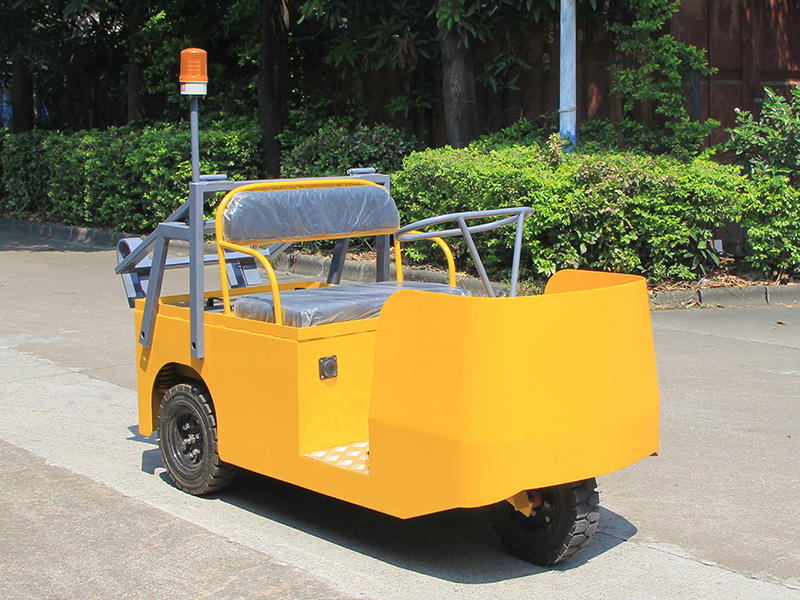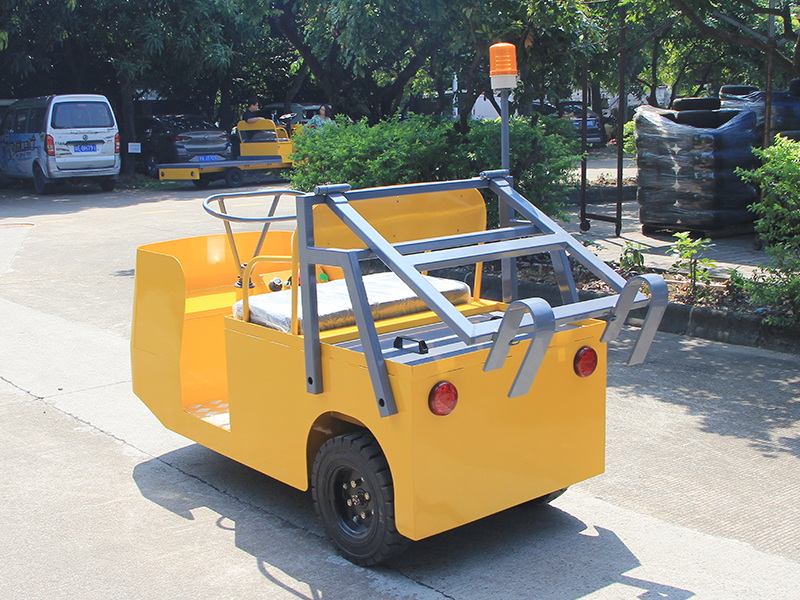Content Menu
● Understanding the Basics
>> What Are Electric Towing Tractors?
>> What Are Traditional Golf Carts?
● Key Comparison Factors
>> Power and Performance
>> Environmental Impact
>> Cost and Maintenance
>> Maneuverability and Terrain Adaptability
>> Customization and Usage Flexibility
● Detailed Specifications Example
>> KOLEC DSPX Series Electric Towing Tractor
>> Typical Traditional Electric Golf Cart
● Additional Considerations
>> Safety Features
>> Battery Charging and Infrastructure
>> Application Suitability
● Conclusion
● FAQ
>> 1. What is the main difference between electric towing tractors and traditional golf carts?
>> 2. Are electric towing tractors more environmentally friendly than gasoline golf carts?
>> 3. How long do the batteries last in electric towing tractors and golf carts?
>> 4. Can traditional golf carts be used for towing?
>> 5. What maintenance is required for electric towing tractors compared to traditional golf carts?
In recent years, the landscape of small utility and recreational vehicles has evolved significantly, especially with the rise of electric-powered options. Two popular categories often compared are electric towing tractors and traditional golf carts. Both serve distinct purposes but share some overlapping features. This comprehensive article explores their differences, advantages, and suitability for various applications, supported by detailed specifications, performance insights, and environmental considerations.

Understanding the Basics
What Are Electric Towing Tractors?
Electric towing tractors are specialized vehicles designed primarily for towing heavy loads in industrial, warehouse, airport, or large campus environments. They are built with robust electric motors, strong frames, and features tailored for hauling trailers or carts efficiently over short to medium distances. These tractors are engineered to handle demanding tasks such as moving luggage carts at airports, towing heavy materials in warehouses, or transporting equipment in manufacturing plants.
What Are Traditional Golf Carts?
Traditional golf carts are small vehicles originally designed to transport golfers and their equipment around golf courses. They are also widely used in residential communities, resorts, and campuses for light transportation. These carts can be powered by gasoline or electricity, with electric models gaining popularity due to their eco-friendliness. Golf carts prioritize passenger comfort and convenience, typically featuring seating for two to six people and smooth ride quality on paved or well-maintained paths.
Key Comparison Factors
Power and Performance
| Feature | Electric Towing Tractors | Traditional Golf Carts |
| Primary Function | Heavy towing and hauling | Passenger transport on smooth terrain |
| Motor Power | Typically 2.5 kW or higher AC motors | Smaller motors, less torque |
| Load Capacity | Up to several tons (e.g., 2 to 6 tons) | Usually light loads, passenger weight only |
| Speed | Moderate, around 8-14 km/h | Variable, generally up to 25 km/h (NEV models) |
| Gradeability | Can handle moderate inclines (5-15%) | Limited, designed for flat golf courses |
Electric towing tractors are engineered for power and endurance, capable of towing loads ranging from 2 to 6 tons depending on the model, such as the KOLEC DSPX series or XT20 model with 2.5 kW motors and hydraulic brakes. Traditional golf carts, especially gasoline-powered ones, offer decent speed and acceleration but are not designed for heavy towing.
The motor technology in electric towing tractors often includes AC drive motors with regenerative braking systems that enhance energy efficiency and reduce wear on mechanical brakes. This technology allows for smooth acceleration and controlled deceleration, which is critical when towing heavy loads. Golf carts, on the other hand, typically use smaller DC or AC motors optimized for light loads and passenger comfort rather than torque.
Environmental Impact
Electric towing tractors and electric golf carts share the advantage of zero emissions, contributing to cleaner environments. They operate quietly, reducing noise pollution, which is beneficial in sensitive areas like hospitals, campuses, and resorts.
Gasoline-powered traditional golf carts, while powerful, emit harmful gases and contribute to environmental pollution, making electric alternatives more appealing for eco-conscious users. Additionally, the quiet operation of electric vehicles reduces noise pollution, which is especially important in residential or recreational areas.
Electric towing tractors are often equipped with advanced battery management systems (BMS) that optimize battery life and energy consumption, further enhancing their environmental benefits. Many models use lead-acid batteries, but lithium-ion batteries are becoming more common due to their longer lifespan, lighter weight, and faster charging capabilities.
Cost and Maintenance
| Aspect | Electric Towing Tractors | Traditional Golf Carts |
| Operating Cost | Low (electricity cheaper than gasoline) | Higher for gasoline models; lower for electric |
| Maintenance | Minimal (fewer moving parts, battery upkeep) | Gasoline carts require oil changes, spark plugs, etc. |
| Battery Life | 5-10 years with proper care | Similar battery maintenance for electric carts |
| Initial Cost | Generally higher due to industrial-grade build | Varies; electric golf carts can be affordable |
Electric towing tractors benefit from fewer mechanical components and regenerative braking systems, reducing wear and tear. Electric golf carts also require less maintenance than gas-powered ones, mainly focusing on battery health.
However, the initial purchase price of electric towing tractors tends to be higher due to their heavy-duty construction and specialized features. Over time, the lower operating costs and reduced maintenance requirements often offset this initial investment, especially in commercial or industrial settings where uptime and reliability are critical.
Maintenance for electric towing tractors typically involves regular battery inspections, cleaning and lubricating moving parts, checking brake systems, and ensuring the electrical components are functioning properly. Traditional gasoline golf carts require more frequent engine maintenance, including oil changes, air filter replacements, and spark plug inspections.
Maneuverability and Terrain Adaptability
Electric towing tractors are designed with enhanced maneuverability, including tight turning radii (around 1.6-1.8 meters) and sturdy tires suitable for industrial floors and some outdoor terrains. Their compact size and responsive steering make them ideal for navigating crowded warehouses, factory floors, and airport tarmacs.
Traditional golf carts excel on smooth, flat surfaces like golf courses and paved paths but may struggle on rough or uneven terrain. Their suspension systems and tire designs are optimized for comfort rather than ruggedness, limiting their off-road capabilities.
Some electric towing tractors come equipped with pneumatic tires or specialized tread patterns to improve traction on varied surfaces, including concrete, asphalt, and light gravel. This versatility makes them suitable for both indoor and outdoor applications.
Customization and Usage Flexibility
Electric towing tractors often come with options tailored to specific industrial needs, such as adjustable towing hooks, various battery capacities, and safety features like hydraulic brakes and electric parking brakes. They can be fitted with additional accessories such as cargo racks, toolboxes, or operator protection canopies.
Traditional golf carts can be customized with seating configurations, storage, and even street-legal features (NEVs or LSVs) for broader use beyond golf courses. Accessories like weather enclosures, lighting kits, and upgraded suspension systems are common.
The ability to customize electric towing tractors for specific tasks-such as adding multiple hitch points for towing several trailers or integrating telematics for fleet management-makes them highly adaptable for logistics and material handling operations.

Detailed Specifications Example
KOLEC DSPX Series Electric Towing Tractor
- Maximum Towable Weight: 5,000 - 6,000 kg
- Motor: AC drive motor with regenerative braking
- Battery: 48V / 360-400Ah lead-acid battery
- Speed: 8-14 km/h (loaded/unloaded)
- Dimensions: Length 1975 mm, Width 1100 mm, Height 1250 mm
- Turning Radius: 1650 mm
- Brake: Hydraulic with electric parking brake
- Weight: 1240 - 1360 kg
Typical Traditional Electric Golf Cart
- Passenger Capacity: 2-6 seats
- Motor: Smaller electric motor, typically under 5 kW
- Battery: 36-48V lead-acid or lithium-ion
- Speed: Up to 25 km/h (street-legal models)
- Range: 40-80 miles per charge depending on battery and load
- Noise: Nearly silent operation
- Maintenance: Battery upkeep, tire and brake checks
Additional Considerations
Safety Features
Electric towing tractors often include advanced safety features such as emergency stop buttons, seat belts, horn systems, and robust braking mechanisms to ensure safe operation in busy industrial environments. Their design prioritizes operator protection, with ergonomic seating and easy-to-reach controls.
Traditional golf carts may have basic safety features such as headlights, taillights, and turn signals in street-legal versions. However, their safety systems are generally less robust due to their lower speeds and lighter use cases.
Battery Charging and Infrastructure
Charging infrastructure is a crucial consideration for both vehicle types. Electric towing tractors usually require dedicated charging stations with higher voltage and amperage to recharge large capacity batteries efficiently during off-hours. Fast charging options are emerging, reducing downtime.
Golf carts often use simpler charging setups, with many models capable of charging overnight on standard electrical outlets. Lithium-ion battery models offer faster charging and longer range but come at a higher upfront cost.
Application Suitability
- Electric Towing Tractors: Ideal for logistics, manufacturing, airports, warehouses, and large campuses requiring frequent towing of heavy loads. Their durability and power make them indispensable for material handling and transport operations.
- Traditional Golf Carts: Best suited for recreational use, short-distance passenger transport, and light utility tasks in environments like golf courses, resorts, gated communities, and university campuses.
Conclusion
Electric towing tractors and traditional golf carts serve distinct but sometimes overlapping roles. If your primary need is heavy-duty towing in industrial or large campus settings, electric towing tractors offer superior power, durability, and customization. Conversely, traditional golf carts excel in passenger transport on golf courses, resorts, and neighborhoods, especially with electric models providing quiet, eco-friendly operation.
Choosing between them depends on your specific application, load requirements, terrain, and environmental priorities. Both vehicle types are advancing with technology, making electric options increasingly attractive for their efficiency and sustainability. As electric vehicle technology continues to evolve, expect improvements in battery life, charging speed, and vehicle versatility, further narrowing the gap between these two categories in some use cases.

FAQ
1. What is the main difference between electric towing tractors and traditional golf carts?
Electric towing tractors are designed for heavy-duty towing and hauling with higher load capacities and robust motors, while traditional golf carts focus on passenger transport over smooth terrain with lighter loads.
2. Are electric towing tractors more environmentally friendly than gasoline golf carts?
Yes, electric towing tractors produce zero emissions and operate quietly, reducing environmental impact compared to gasoline-powered golf carts that emit harmful gases.
3. How long do the batteries last in electric towing tractors and golf carts?
With proper maintenance, batteries in both electric towing tractors and golf carts typically last between 5 to 10 years, depending on usage and battery type.
4. Can traditional golf carts be used for towing?
Traditional golf carts can tow light loads but are not designed for heavy towing. For substantial towing needs, electric towing tractors are more suitable.
5. What maintenance is required for electric towing tractors compared to traditional golf carts?
Electric towing tractors require minimal maintenance focused on battery care and brake systems, while traditional gasoline golf carts need regular engine maintenance. Electric golf carts share similar low maintenance needs with towing tractors.










































